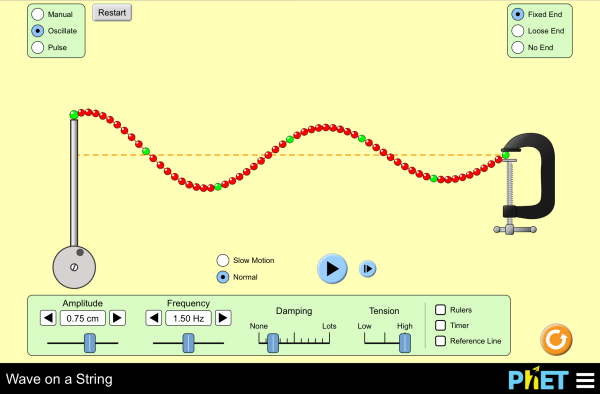Students explore the PhET Interactive Simulation “Wave on a String” focusing on amplitude and frequency as well as wave travel.
Science Topics
Sound
Waves
Process Skills
Observing
Inferring
Comparing
Grade Level
6-12
Preparation
5-10 minutes
Activity
30 minutes
Clean-Up
5 minutes
Learning Goals
Students will be able to:
- model and describe amplitude and frequency
- explain the difference between the direction of the wave travel and the string of motion
as a wave travels on it - describe how and if amplitude, frequency, damping and tension effect how fast a wave
travels
Materials not in Kit
Computer* with “Wave on a String” from PhET Interactive Simulations
Optional Materials
Slinky, string, or rope
Set-Up
If you are doing this in class, set up the simulator on classroom computers by going to: https://phet.colorado.edu/en/simulation/wave-on-a-string
Clicking the triangular play button will allow you to use the simulator on your internet browser.
You can also download the simulator by clicking the download button.
Introduce the Activity
No Introduction is needed. This simulation has been tested with students from grade school to college, and the interface has been intuitive for all students tested. We have observed that too much instruction on the simulation creates a barrier between the students and the simulation. If they explore on their own, it becomes “their” simulation.
Doing the Activity
Simulating Sound
- Pass out the worksheets (either as homework or as an in-class activity).
- Students will use the simulator to answer the questions.
- For question 6, students will make a chart to show how the speed varies with several different factors.
Explanation
Wave on a String demonstrates transverse waves. The wave travels to the right in the simulation while the string moves up and down. This idea can be related to the class doing “the wave.”
When investigating the speed that the wave travels, students will see that the amplitude, frequency and damping do not affect the speed that the wave travels, but that tension does. The speed of sound, for example, is dependent on the medium it travels through (air, water, on a string). The amplitude affects loudness, the frequency affects the pitch and damping affects how quickly the sound dissipates. The loudness, pitch or damping do not affect how fast sound travels. Tension, on the other hand, does since it is related to the medium the sound travels through so it does affect the speed of the wave. Another example would be earthquake waves. The density and elasticity of the rock affects wave speed not amplitude, frequency or damping.
Key Lesson Terminology
Amplitude – for transverse waves, it is the maximum height of the wave. Larger amplitudes create louder sounds.
Frequency – wiggles per second (moves back and forth)
Damping – dissipation of energy with time or distance
Tension – how tightly the string is stretched
Optional Extensions
- The Anatomy of a Wave (middle school & high school) is good to continue working on the basic properties of transverse and longitudinal waves, including resonance.
- Create a wave on a string in the classroom by using a long string/slinky or rope. It should be possible to change the amplitude, frequency and tension while oscillating the string/slinky/rope. It is difficult to change damping, however.
Specific subject extensions:
- Sound – investigate the Sound Sim on the PhET website so that students understand that amplitude relates to how loud sound is and frequency relates to the pitch that we hear. Then discuss how the speed of sound cannot vary with amplitude and pitch or else if you listen to music from far way, it should be a mess!! You would not hear the flutes the same time as the bass cello etc… If it
depended on loudness, it would be even stranger. - Earthquakes – after this, lesson students are more ready to learn about Primary and Secondary seismic waves and how they travel through the earth. The idea https://exploresound.org/wp-admin/post-new.php#that depending on the part so the earth the wave travels through, it may arrive at a location at a different time.
- Light – teach students the relationship between the color of light and the frequency. Also brightness with amplitude. After learning about these ideas, talk about how objects would appear if frequency changed the speed of light. Far away moving objects would be a sort of smeared rainbow.
Modifications
The PhET website can be viewed in many languages, and learners can experiences the simulations in their native language to help them fully understand the material being presented


